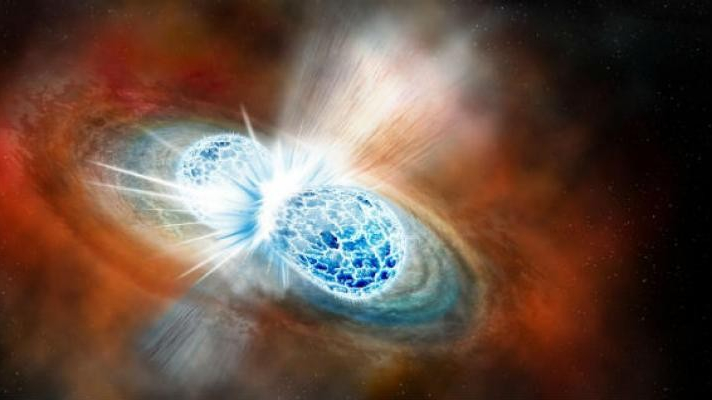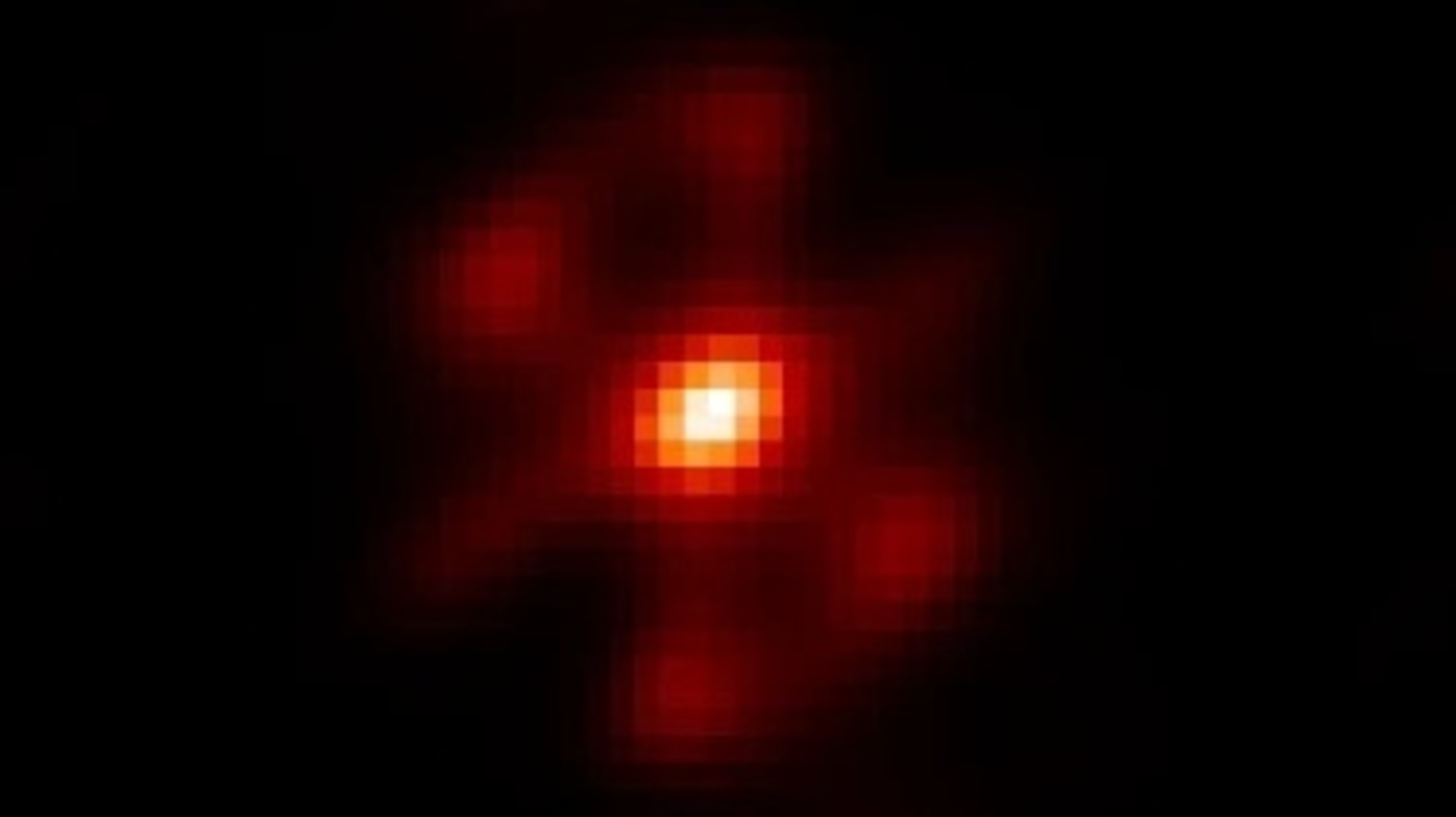What happens when neutron stars collide? Astronomers may finally know
Researchers used advanced computers and real observations to see the 3D shape of light emanating from a merger between ultradense stellar bodies.

Scientists have used advanced computer modeling to determine the shape of a kilonova, an emission of light that follows the collision and merger of two neutron stars. Extraordinarily, the team discovered that rather than being shaped like smooth, homogeneous spheres or flattened, disk-like explosions, the kilonovas they simulated were filled with "blobs," or "bubbles."
"This is a significant step forward in the theoretical understanding of what’s going on in neutron star mergers," Stuart Sim, co-author of a study on the findings and a physicist at the University of Belfast, told Space.com.
Determining what goes on during a neutron star collision also has important implications close to home. That's because it's believed that the turbulent environments that give rise to kilonovas are the only sites in the universe suitable to forge elements heavier than lead — including the gold that we use for jewelry here on Earth. It is hoped that studying kilonovas could reveal more about this process.
"Kilonovas are the light signals from neutron star mergers, which are the origin of about half of all nuclei heavier than iron. Almost all of the platinum and gold that exists today was created from neutron star mergers," Luke Shingles, lead author of the research and a scientists at the Facility for Antiproton and Ion Research told Space.com. "The 3D structure seems to be very important, and it might be necessary to have a kind of foamy structure with small clumps and bubbles, rather than a smooth ellipsoid type of shape that many people were assuming.
"If our model is a good one, then we also know the full pattern of elements that were created in these types of events."
Related: James Webb Space Telescope spots violent collision between neutron stars
Why neutron star collisions are a unique laboratory for physics
It is hardly surprising that collisions between neutron stars generate such violent conditions, considering these stellar remnants consist of the densest material in the known universe.
Breaking space news, the latest updates on rocket launches, skywatching events and more!
That's because neutron stars are born when massive stars run out of the fuel necessary for nuclear fusion processes in their cores, and can therefore no longer generate the outward push that has supported them against the inward push of gravity for billions of years. Then, as the star's core collapses, the outer layers of the star are ejected, resulting in a body with a mass between one and two times that of the sun with a width of around 12 miles (20 kilometers) — a neutron star.
This resulting neutron star is so dense that if a teaspoon's worth of it could be brought to Earth, it would weigh about 10 million tons — that's 30 times as heavy as the Empire State Building in New York City.
As such, neutron star mergers make for a unique laboratory where it is possible to study things it would be impossible to simulate here on Earth, meaning research like the team's new study is vital far beyond astrophysics.
"In terrestrial experiments, you can never encounter matter that is as dense as neutral star matter," Sim added. "So there are fundamental questions that kind of relate to aspects of particle physics and quantum chromodynamics, and they are relevant to determining just how dense neutron star matter actually is and how neutron star matter will respond to this dynamical process of being squished together."
Just like the real thing
What the team did find surprising, however, was just how closely their computer-generated models fit real-life observations of a kilonova known as AT2017gfo, created by the clash between two neutron stars sitting about 130 million light-years away from us in the galaxy NGC 4993.
Shingles explained whyAT2017gfo was the only real choice for comparison to the team's advanced simulations. "It is the only one that has been very well observed and for which we have really good spectra taken every few hours," he said. "There are other objects that people think are probably kilonovas but haven’t really enough observations to see in great detail what kilonovas look like."
As for the unexpected bubbliness of the kilonova observed in the simulations, Sim stated that while this is the result of complicated physics and it isn't fully understood yet, what seems to be causing the strange structure is matter ejected during the clash between neutron stars.
"As two neutron stars come together, there are various different mechanisms that cause materials to be expelled," Sim continued. "The particular category of mechanism that we've been most looking at here is as they're starting to push together, material kind of gets 'spurted out' along the axis. As they squash in from the sides, this ejected stuff kind of comes up and goes down."
That stuff then interacts with other particles created by the collision, which can change the composition of the ejected matter.
Another thing that defied the team's expectations was the lack of heavy elements in their models. Sim explained that the team found an abundance of "mid-periodic table" elements, like strontium, but an absence of things like gold and platinum.
"That's a bit of a surprise. It's telling us about nucleosynthesis that's actually going on. And it's suggesting that these things are producing a lot of these sorts of medium elements," Sim said. "But we don’t yet have really definitive evidence of the very heaviest ones. It's very likely the case that the heavy elements are there, but they're just harder to directly identify in this particular object. That's something that we're going to be continuing to work on."
Looking at kilonovas from all angles
In this simulation, the team modeled the clash of two neutron stars with masses around 1.3 times that of the sun. Other simulations of neutron star collisions are also currently underway, in which the team has changed the mass of the clashing neutron stars as well as the dynamics of matter at play during the mergers.
"We hope, within a few years, we will have many simulations similar to this one, and we'll be able to cross-compare them and see what things are likely to vary from case to case," Sim added. "Hopefully, we'll also have observations of more real kilonova to see how much real variation there is in this observed class of events."
The researcher also believes the 3D shape of the model he and his colleagues created could help astronomers identify kilonovas in observations by giving them an idea of what they look like from a multitude of angles.
"What this simulation predicts is that depending on the direction you look at the kilonova, you will see different things. So there are some directions you can look at it, and it looks very much like AT2017gfo," Sim concluded. "But the simulation suggests that if you look at a kilonova from a 90-degree difference in direction, you would see something quite different. So there is a prediction there about the degree of variation that the observers should be looking out for, so they definitely shouldn’t throw something away just because it doesn’t quite look like AT2017gfo. It could still be a kilonova."
The team’s research was published on Sept. 8 in the Astrophysical Journal Letters.

Robert Lea is a science journalist in the U.K. whose articles have been published in Physics World, New Scientist, Astronomy Magazine, All About Space, Newsweek and ZME Science. He also writes about science communication for Elsevier and the European Journal of Physics. Rob holds a bachelor of science degree in physics and astronomy from the U.K.’s Open University. Follow him on Twitter @sciencef1rst.
